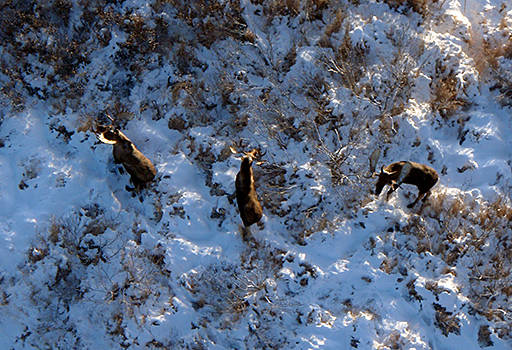Since the 1920s, mammals of 14 species have been transplanted from one location — mostly but not always in Alaska — to another location in Southeast. Many of the official transplants were done with the hope of establishing viable populations of game species in new places, with the goal of providing more prey for humans. The processes of capturing and transporting the unwilling immigrants commonly resulted in high mortality, even before the animals were deposited in their new sites.
Many of the transplantations failed. An attempt to establish a moose population near the Chickamin River in the 1960s failed altogether; all the transplanted young moose died. At that time, officials declared it was too expensive to do a preliminary habitat assessment and thought it more practical to just dump the moose there and see what happened. A number of other transplant attempts over several decades are said to have failed: deer to the Taiya Valley, goats to Chichagof, mink to Strait Island, muskrats and marmot to Prince of Wales, wolf to Coronation Island, snowshoe hare to Admiralty and other islands. Ill-advised attempts in the ’40s and ’50s to establish populations of non-native raccoons failed.
Some transplants were successful, apparently without any serious preliminary assessments: The mountain goats now living on Baranof are descendants of the transplants in the 1920s, and marten were moved to Prince of Wales, Baranof and Chichagof in the 1940s and 1950s. After a habitat assessment in Berners Bay, a number of young moose were deposited there in 1958 and 1960; they established themselves successfully and that local population has grown. It may be emigrants from that area that we observe near Cowee Creek, Herbert River and the Mendenhall Glacier. The possible effects of moose browsing on the structure of the vegetation in Berners Bay are apparently not known; given the notable cropping of willows and other shrubs in Gustavus, one might wonder about the effects on nesting habitats for birds — especially in the light of research elsewhere documenting that over-browsing can drastically reduce bird habitat.
[See photos of Mother Nature in Alaska]
Elk — a non-native species — were brought to four islands in Southeast in the mid to late 1900s. The elk from Oregon and Washington were exchanged for mountain goats from Alaska. Only the 1987 introduction of elk to Etolin Island was successful, and elk eventually dispersed from there to nearby Zarembo and other islands. Some preliminary habitat assessments were made, but post-facto concern about possible competition with existing deer populations arose, so continued monitoring and perhaps management are necessary.
After marten were transplanted to the three big islands, red squirrels were often introduced as prey for marten. It later became clear that marten really prefer voles and it is unlikely that the squirrel transplants had much effect on the introduced marten populations. However, it is very likely that the squirrels are having a negative impact on nesting birds on those islands, because they prey on eggs and nestlings.
Collectively, these attempts to establish new populations of mammals are a very mixed bag. There was a high cost in mortality of animals (not to mention dollar costs of capture and transport), many transplant efforts failed, and there was little attention paid to possible consequences. The impetus for game translocations in Southeast may have abated somewhat, and as our ecological understanding has grown over the years, it seems likely that any further transplants would be done with greater concern not only for the animals themselves but also for proper preliminary assessments and the ecological consequences.
Several additional transplants were done in attempts to augment existing populations or to re-establish a previously resident population. However, the effect of adding new animals to an existing population — deer to Kupreanof in 1979, for example — is usually unknown. A transplant effort in 1989 attempted to restore a much-reduced population of mountain goats on Mount Juneau, with the stated intent of improved wildlife viewing (!). All the transported goats initially moved away, but by the early 2000s, goats were again seen on the ridge, although no one seems to know if these animals are related to the transplants or from a natural population on nearby ridges.
Sea otters have been re-introduced to many places in Southeast at various times, to restore the natural population that was extirpated by human activity. These transplants are apparently successful and the population of sea otters in Southeast is growing. The consequences of sea otter presence are currently being studied by faculty and students of UAF.
The historical information in this essay derived from Tom Paul’s 2009 ‘Game Transplants in Alaska”, Alaska Department of Fish and Game’s Technical Bulletin No.4. In addition to the official transplantations, there have been an unknown number of unofficial and mostly unrecorded ones, done by private citizens.
Mary F. Willson is a retired professor of ecology. “On The Trails” is a weekly column that appears every Wednesday.

